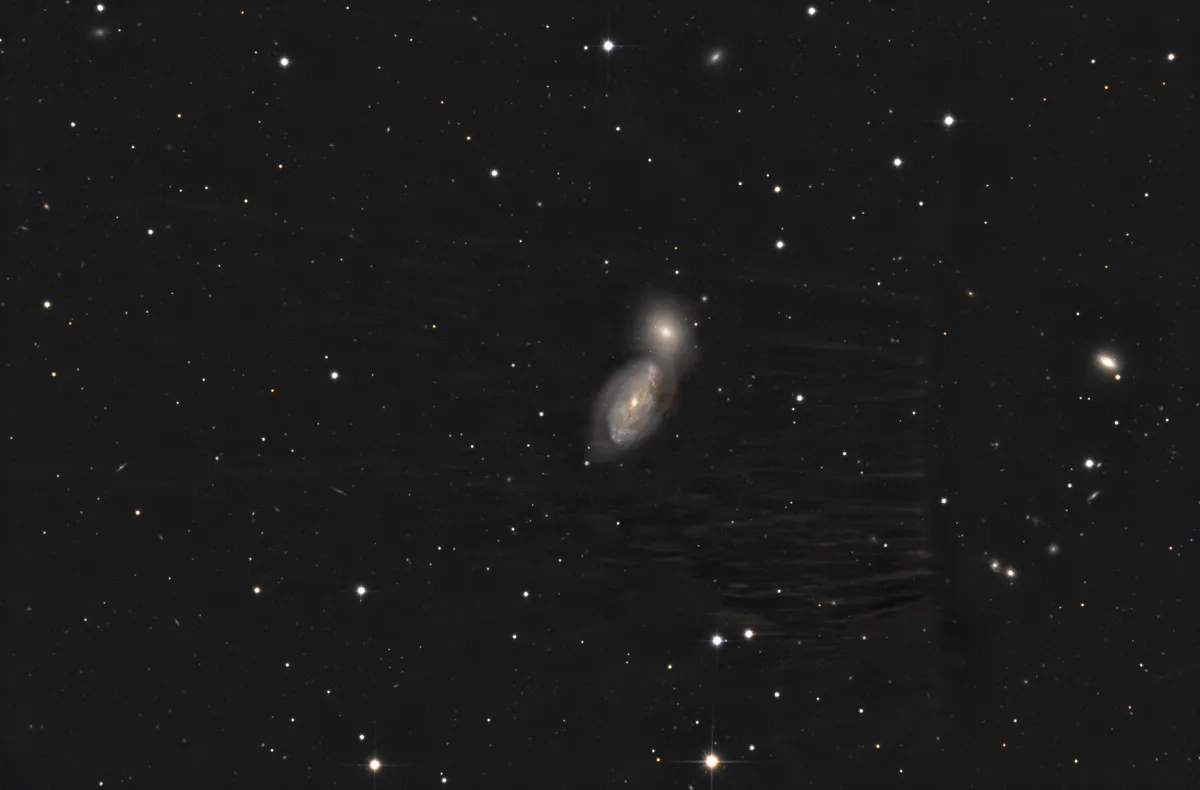Pair of Galaxies NGC 3226/7 (Arp 94)

History
In the night of 15 February 1784 the German-British astronomer Sir William Herschel observed two «faint nebulae» using his 18.7 inch reflecting telescope. He classified them as II 28 and II 29 and noted: «Two, about 2' asunder. Both faint, considerably large, round.» [463]. The pair of nebulae later became NGC 3226 and NGC 3227 in Dreyers «New General Catalogue». In March 1855 the German astronomer August Winnecke pointed the 9.6 inch Fraunhofer refractor at Berlin Observatory discovered at these galaxies and found about 13 arcminutes west of it a faint galaxy which later was cataloged as NGC 3222. [274]
The pair of galaxies is also known as Holm 187, based on a catalogue [532] of double and multiple galaxies, compiled in 1937 by the Swedish Astronomer Erik Holmberg.
The American astronomer Halton Arp published in 1966 his famous «Atlas of Peculiar Galaxies», in which he divided galaxies into groups based on purely morphological criteria. The pair of galaxies here received the designation Arp 94 (APG 94) as an elliptical galaxy with companion. He noted: «Companion on edge of large, very faint loop extending opposite galaxy.» [199]

Physical Properties
NGC 3227 is a large spiral galaxy, wrapped in a turbulent gravitational dance with its companion, the elliptical galaxy NGC 3226. Both are between 50 and 60 million light-years away from us. The area between the two galaxies reveals faint tidal streams of gas and dust. NGC 3227 is a Seyfert galaxy, a type of galaxy with a very active nucleus. These galaxies hold supermassive black holes at their cores. As matter spirals into the black hole, it releases vast amounts of radiation along the black hole’s axis of rotation, giving the galaxy its active nucleus. [533]
| Name | RA | Dec | Type | bMag | vMag | B-V | SB | Dim | PA | z | D(z) | MD | Dreyer Description | Identification, Remarks |
|---|---|---|---|---|---|---|---|---|---|---|---|---|---|---|
| NGC 3222 | 10 22 34.4 | +19 53 12 | Gx (SB0) | 13.7 | 12.8 | 0.9 | 13.0 | 1.2 × 1 | 51 | 0.018630 | 78.69 | F, lbM, rr (Schultz, bi N), Auw 27 | GC 2084; UGC 5610; MCG 3-27-11; CGCG 94-18 | |
| NGC 3226 | 10 23 26.9 | +19 53 51 | Gx (E2) | 12.3 | 11.4 | 0.9 | 13.7 | 2.8 × 2 | 29 | 0.003839 | 16.22 | 29.840 | pB, cL, R, D neb, 159°, 138" | WH II 28; GC 2088; UGC 5617; MCG 3-27-15; CGCG 94-26; KCPG 234A; Arp 94; VV 209 |
| NGC 3227 | 10 23 30.4 | +19 51 55 | Gx (SBa) | 11.1 | 10.3 | 0.8 | 13.4 | 4.1 × 3.9 | 150 | 0.003859 | 16.30 | 20.850 | pB, cL, R, D neb, 159°, 138" | WH II 29; GC 2089; UGC 5620; MCG 3-27-16; CGCG 94-28; IRAS 10207+2007; Arp 94; VV 209; KCPG 234B |
Finder Chart
The pair of galaxies NGC 3226/7 is located almost 1° east of star γ1 Leonis (Algieba) in the constellation Leo. The best time for observation is November to July.
Visual Observation
762 mm Aperture: One galaxy is roundish or almost circular, the other more elongated. The nuclei are stellar and of similar brightness to the surrounding stars. — 30" SlipStream-Dobson f/3.3, Hasliberg, 14. 2. 2023, Eduard von Bergen
